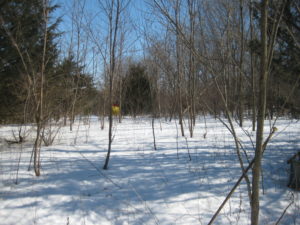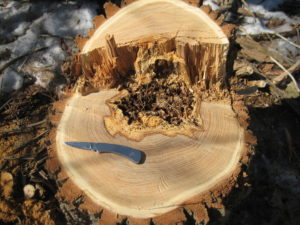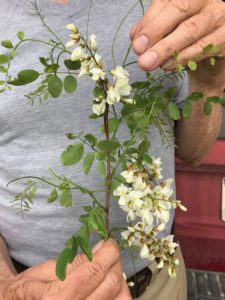Black Locust: A Woodland Invasive

Young black locust invading a former hayfield, my glove for scale.
Black locust is probably a native of somewhere in the Appalachians. The uncertainty is because it’s hard and heavy wood is resistant to decay at the soil line, so it is useful for fence posts. Thus, the early settlers planted its seed as soon as they arrived and it has been part of local records for as long as anyone has been keeping track. Once established, black locust will seed and sucker and take over abandoned crop land and poorly maintained pastures.
And so to an Iowa Conservationist today, this is an aggressive invader, especially in woodlands.
Modern agriculture doesn’t grow its own fence posts anymore, and the species has lost the major predator of its youth – a guy with a chainsaw. Once it reaches 6-12” in diameter, a certain fungus invades and the center of the trunk begins to decay.

A freshly cut black locust stump. Note the thick, deeply furrowed bark, the thin, pale sapwood beyond the pocketknife blade tip, and the very decayed center.
At a later stage of decay, the fungus creates an external fruiting body called a konk, usually high in the tree, which scatters the fungal spores. When young the konk is yellow brown and with age turns black. And finally, long before its 100th birthday, the increasingly hollow tree, still made of very strong outer wood, will shatter in a summer storm with a sharp crack that resembles a gunshot.
Like many of its legume cousins, black locust has flowers that look much like those of garden peas and beans. They are always white, very fragrant, and can often be seen from a great distance when the older trees are well-established in a woodlot and the flowers are in the upper canopy.

Black locust flowers
But there is a red flag behind the pretty flowers. In his book A Manual of Poisonous Plants, Professor Pammel points out assorted poisonous properties of black locust. Page 57 notes that the bark, leaves, and flowers are poisonous. On page 64 he says that, “Toxic honey has been gathered from the flowers…”, and on page 66 he says the flowers produce toxic nectar. On page 149 he identifies one of the toxins as toxabumin. Pammel was a botany professor at Ames a century ago and his book is focused especially upon Iowa plants.
On pages 56-57 Pammel provides a detailed description of the poisoning of a horse that had chewed on the bark of a young black locust. It leads me to suggest that the bark and wood of this species be avoided for cooking fires, smoking meat, BBQ skewers, marshmallow sticks, and any other culinary applications.
However if you have good smoke control, (which you should in a house and if not you should get it fixed), it makes good firewood. Denser than oak or hickory, it makes a bed of glowing coals only rivaled by red elm. If properly dried, a cord of black locust has nearly the BTU value of a ton of anthracite. Last winter I burned mostly green, fresh cut black locust, using other dry wood to start the fire each day.
You might imagine that a fine-grained wood that is harder, stronger, more durable, and takes a better finish than oak or hickory would be just the lumber we need for really rigorous applications. But you won’t find black locust lumber at hardwood outlets because the tree starts to go hollow at an early age and you can rarely get a decent board from it.
So if you are trying to convert a woodland back to its native condition and are removing black locust, I think that its only uses would be firewood and brush piles – taking care with how the firewood is used.


